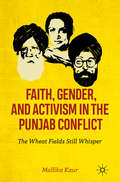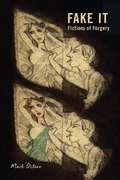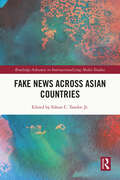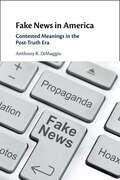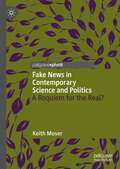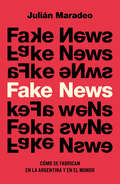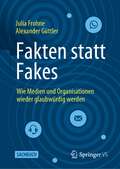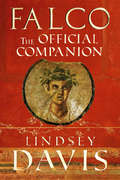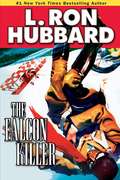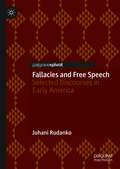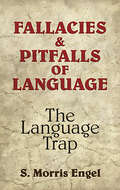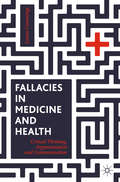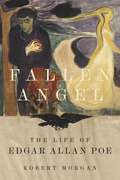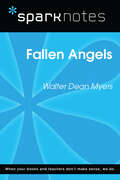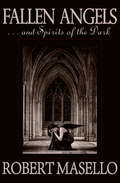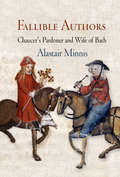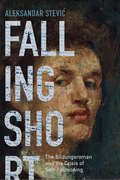- Table View
- List View
Faith, Gender, and Activism in the Punjab Conflict: The Wheat Fields Still Whisper
by Mallika KaurPunjab was the arena of one of the first major armed conflicts of post-colonial India. During its deadliest decade, as many as 250,000 people were killed. This book makes an urgent intervention in the history of the conflict, which to date has been characterized by a fixation on sensational violence—or ignored altogether. Mallika Kaur unearths the stories of three people who found themselves at the center of Punjab’s human rights movement: Baljit Kaur, who armed herself with a video camera to record essential evidence of the conflict; Justice Ajit Singh Bains, who became a beloved “people’s judge”; and Inderjit Singh Jaijee, who returned to Punjab to document abuses even as other elites were fleeing. Together, they are credited with saving countless lives. Braiding oral histories, personal snapshots, and primary documents recovered from at-risk archives, Kaur shows that when entire conflicts are marginalized, we miss essential stories: stories of faith, feminist action, and the power of citizen-activists.
Faithful Passages: American Catholicism in Literary Culture, 1844-1931
by James Emmett RyanRoman Catholic writers in colonial America played only a minority role in debates about religion, politics, morality, national identity, and literary culture. However, the commercial print revolution of the nineteenth century, combined with the arrival of many European Catholic immigrants, provided a vibrant evangelical nexus in which Roman Catholic print discourse would thrive among a tightly knit circle of American writers and readers. James Emmett Ryan's pathbreaking study follows the careers of important nineteenth-century religionists including Orestes Brownson, Isaac Hecker, Anna Hanson Dorsey, and Cardinal James Gibbons, tracing the distinctive literature that they created during the years that non-Catholic writers like Herman Melville and Emily Dickinson were producing iconic works of American literature. Faithful Passagesalso reveals new dimensions in American religious literary culture by moving beyond the antebellum period to consider how the first important cohort of Catholic writers shaped their message for subsequent generations of readers in the late nineteenth and early twentieth centuries. Perhaps most strikingly, Ryan shows that by the early twentieth century, Roman Catholic themes and traditions in American literature would be advanced in complex ways by mainstream, non-Catholic modernist writers like Kate Chopin and Willa Cather. Catholic literary culture in the United States took shape in a myriad of ways and at the hands of diverse participants. The process by which Roman Catholic ideas, themes, and moralities were shared and adapted by writers with highly differentiated beliefs, Ryan contends, illuminates a surprising fluidity of religious commitment and expression in early U. S. literary culture.
Faithful Vision: Treatments of the Sacred, Spiritual, and Supernatural in Twentieth-Century African American Fiction (Southern Literary Studies)
by James W. Coleman"This is a marvelous and sustained discussion of 'faithful vision' and its significant influence on African American literature." -- American LiteratureIn Faithful Vision, James W. Coleman places under his critical lens a wide array of African American novels written during the last half of the twentieth century. In doing so, he demonstrates that religious vision not only informs black literature but also serves as a foundation for black culture generally. The Judeo-Christian tradition, according to Coleman, is the primary component of the African American spiritual perspective, though its syncretism with voodoo/hoodoo -- a religion transported from West Africa through the West Indies and New Orleans to the rest of black America -- also figures largely. Reviewing novels written mainly since 1950 by writers including James Baldwin, Randall Kenan, Toni Morrison, John Edgar Wideman, Alice Walker, Gloria Naylor, Erna Brodber, and Ishmael Reed, among others, Coleman explores how black authors have addressed the relevance of faith, especially as it relates to an oppressive Christian tradition. He shows that their novels -- no matter how critical of the sacred or supernatural, or how skeptical the characters' viewpoints -- ultimately never reject the vision of faith. With its focus on religious experience and tradition and its wider discussion of history, philosophy, gender, and postmodernism, Faithful Vision brings a bold critical dimension to African American literary studies."An insightful interrogation of the complexities of religious discourse in the African American literary tradition. Because it superbly translates complex spiritual ethos into literary tradition, this remarkable book is a must for anyone interested in intersections of the sacred and the secular in black cultural productions." -- Southern Literary Journal"Faithful Vision both looks intently into faith and shows us how to look." -- Christianity and Literature
Fake Heroes: Ten False Icons and How they Altered the Course of History
by Otto EnglishFrom the author of Fake History, Otto English, comes a shocking yet hilarious look at ten of the greatest liars from our past, examining these previously unquestioned idols and exposing what they were trying to hide.'A brilliant book.' James O'BrienWas Che Guevara really a revolutionary hero?Should Mother Teresa be honoured as a saint?Is Henry V actually England's greatest king?And why does JFK's legend continue to grow?Having exposed some of the greatest lies ever told in Fake History, journalist Otto English turns his attention to some of history's biggest (and most beloved) figures.Whether it's virtuous leaders in just wars, martyrs sacrificing all for a cause, or innovators changing the world for the better, down the centuries supposedly great men and women have risen to become household names, saints and heroes. But just how deserving are they of their reputations?Exploring everything from Captain Scott's reckless hunt for glory and Andy Warhol's flagrant thievery to Coco Chanel's murky Nazi past, Otto English dives into the hidden lives of some of history's most recognisable names. Scrutinising figures from the worlds of art, politics, business, religion and royalty, he brings to light the murkier truths they would rather have kept buried away, at the same time as celebrating the unsung heroes lost to time.Fake Heroes exposes the truth of the past and helps us understand why that matters today.
Fake It: Fictions of Forgery
by Mark OsteenHow many layers of artifice can one artwork contain? How does forgery unsettle our notions of originality and creativity? Looking at both the literary and art worlds, Fake It investigates a set of fictional forgeries and hoaxes alongside their real-life inspirations and parallels. Mark Osteen shows how any forgery or hoax is only as good as its authenticating story—and demonstrates how forgeries foster fresh authorial identities while being deeply intertextual and frequently quite original. From fakes of the late eighteenth century, such as Thomas Chatterton’s Rowley poems and the notorious "Shakespearean" documents fabricated by William-Henry Ireland, to hoaxes of the modern period, such as Clifford Irving’s fake autobiography of Howard Hughes, the infamous Ern Malley forgeries, and the audacious authorial masquerades of Percival Everett, Osteen lays bare provocative truths about the conflicts between aesthetic and economic value. In doing so he illuminates the process of artistic creation, which emerges as collaborative and imitative rather than individual and inspired, revealing that authorship is, to some degree, always forged.
Fake News Across Asian Countries (Routledge Advances in Internationalizing Media Studies)
by Edson C. TandocThis book integrates insights from studies conducted across Asia to provide a comprehensive account of the fake news problem in the region.Emerging from a study on how Singapore stakeholders define, determine, and deal with online falsehoods, the volume expands to cover numerous Asian contexts, all of which have experienced the problem in not only similar but also unique ways, coupled with diverse cultures and media regulatory contexts. Drawing from specific examples and case studies to demonstrate the real-world manifestation of the concepts and theories on fake news, the book grounds academic research in lived experiences.This volume will interest journalism scholars and undergraduate and postgraduate students in the areas of media studies, mass communication, digital media, media literacy, Asian studies, and political communication.
Fake News in America: Contested Meanings in the Post-Truth Era
by Anthony R. DiMaggioThe term 'fake news' became a buzzword during Donald Trump's presidency, yet it is a term that means very different things to different people. This pioneering book provides a comprehensive examination of what Americans mean when they talk about fake news in contemporary politics, mass media, and societal discourse, and explores the various factors that contribute to this, such as the power of language, political parties, ideology, media, and socialization. By analysing a range of case studies across war, political corruption, climate change, conspiracy theories, electoral politics, and the Covid-19 pandemic, it demonstrates how fake news is a fundamentally contested phenomenon, and how its meaning varies depending on the person using the term, and the political context. It provides readers with tools to identify, talk about, and resist fake news, and emphasizes a need for education reform with an eye toward promoting critical thinking and information literacy.
Fake News in Contemporary Science and Politics: A Requiem for the Real?
by Keith MoserThis transdisciplinary book investigates the profound repercussions of living in a post-truth world in which 'alternative facts' and post-truth knowledge claims, often bordering on the absurd, have replaced the real in the collective imagination of millions of people around the planet. Through discussions on climate change denial, the anti-vaccination movement, the January 6th Insurrection and the Russia-Ukraine War, this study explores the gravity of the current 'infodemic,' or the increasing inability of a large segment of the population to distinguish between reality and misrepresentation, and the destabilizing impact this infodemic has on democratic models of governance around the globe, coinciding with the rise of autocratic forms of populism.
Fake News, Hashtags & Social Bots: Neue Methoden populistischer Propaganda (Aktivismus- und Propagandaforschung)
by Klaus Sachs-Hombach Bernd ZywietzDer Band versammelt Beiträge zum Thema der gegenwärtigen „digitalen“ Propaganda, wie sie im Kontext des Populismus eine besondere Rolle spielt. Sie wird als politisch-mediales Phänomen analysiert und als gesellschaftlich-kommunikatives Herausforderung: dies hinsichtlich der Sorge vor der einseitigen Beeinflussung einer neuen, fragmentierten „Masse“ im Netz sowie um die für medienvermittelte Demokratien fundamentale Möglichkeit des vertrauensvollen Austausches von Informationen und Meinungen auf Basis diskursethischer Prinzipien.
Fake News: Separating Truth from Fiction
by Michael MillerWhile popularized by President Donald Trump, the term "fake news" actually originated toward the end of the 19th century, in an era of rampant yellow journalism. Since then, it has come to encompass a broad universe of news stories and marketing strategies ranging from outright lies, propaganda, and conspiracy theories to hoaxes, opinion pieces, and satire—all facilitated and manipulated by social media platforms. This title explores journalistic and fact-checking standards, Constitutional protections, and real-world case studies, helping readers identify the mechanics, perpetrators, motives, and psychology of fake news. A final chapter explores methods for assessing and avoiding the spread of fake news.
Fake news: Cómo se fabrican en la Argentina y en el mundo
by Julián MaradeoA partir de casos locales y del mundo, el libro cuenta la historia de las noticias falsas, de cómo nos ponen en estado de alerta y, al mismo tiempo, refleja la debilidad estatal, la falta de control y el enorme lobby alrededor de ellas. La imagen de una chica con su bebé en brazos mientras carga en la espalda una caja térmica de delivery es la punta del iceberg de un fenómeno que sacudió las nociones de verdad y mentira: las fake news. Todos estamos expuestos y a la vez las reproducimos hasta convertirlas en pandémicas. Sus consecuencias pueden alterar elecciones, decisiones de gobierno e incluso provocar muertes. A partir de casos locales y del mundo, el libro cuenta la historia de las noticias falsas, de cómo nos ponen en estado de alerta y, al mismo tiempo, reflejan la debilidad estatal, la falta de control y el enorme lobby alrededor de ellas. «Esta investigación -dice Julián Maradeo- trata sobre otra forma de ejercer el poder. Una que es imperceptible, escurridiza, placentera y extraterritorial. Una que jaquea a todas las teorías que discurrieron por siglos al respecto. Una en la que interviene un lenguaje que resulta ajeno, sujetos que parecen salidos de una película, geografías remotas. Una que pone en entredicho las reglas del juego democrático. Las noticias falsas no discriminan entre Oriente y Occidente, afectan a todos sin mirar a quién».
Fakten statt Fakes: Wie Medien und Organisationen wieder glaubwürdig werden
by Julia Frohne Alexander GüttlerFake News, PR-Skandal, Mainstream-Presse – diese Schlagworte kennzeichnen vor allem eines: den Vertrauensverlust der Öffentlichkeit in die Berichterstattung von Medien und Unternehmen. In einem nahezu unentwirrbaren Kommunikationsdschungel aus Medien, Internetportalen und sozialen Plattformen wird es nicht nur für Laien immer schwieriger, verlässliche und unseriöse Kommunikation voneinander zu unterscheiden.So steigt die Anzahl derer, die professioneller Kommunikation mit Misstrauen begegnen und in ihr vor allem Einflussnahme oder gar Manipulation sehen. Aus den Augen gerät dabei oft, dass Deutschland über eines der freiheitlichsten und vielfältigsten Mediensysteme der Welt verfügt.Das Buch diskutiert die Grenzen zwischen Manipulation und Kommunikation on- wie offline und zeigt, wie man schlampige und seriöse Meinungsmacher unterscheidet, welche Rolle Fakten spielen und wie Medien und Unternehmen dazu beitragen können, dass Glaubwürdigkeit in der medialen Debatte wieder einen Stellenwert bekommt.
Fakten · Bilder · Töne · Story: Dokumentarische Filmdramaturgie: TV · Video · Netz · Kino (Journalistische Praxis)
by Gregor Alexander HeussenDokumentarische Filme aller Genres in TV, Kino und Netz entfalten ihre informative Kraft erst dann, wenn sie dramaturgisch als Erzählungen strukturiert sind, nicht als Aufzählungen. Sie müssen die Emotionen des Publikums wecken, damit die filmische Information verstanden werden kann. Wirksame dokumentarische Filmgestaltung ist begründet in der Art, wie Menschen hinschauen und hinhören. Ihre Wahrnehmungen werden zu Vorstellungen; diese prägen die Information. Dadurch verändern sich viele überkommene Regeln für Dokumentarische Filme. Neue Ideen werden möglich. Werkzeuge dafür sind der Erzählsatz, die Roten Fäden, die Drama-Elementarmuster, das konzentrierte Zusammenspiel der sechs filmischen Erzähler, Emotionsziel und Argumentziel und die für Erzählungen charakteristische Polaritätslogik. Anders als fiktionale Filme müssen Dokumentarische Filme durch ihre erzählerische Struktur und filmische Gestaltung einen nachprüfbaren Bezug zur Lebensrealität des Publikums schaffen. Spielfilme hingegen können in ihrem jeweils definierten Erzählkosmos plausibel und authentisch sein. Im Dokumentarischen lassen sich auch Werkzeuge und Muster der Fiktionalen Dramaturgie nutzen, aber mit anderer Absicht und Wirkung: sie müssen die Lebensrealität treffen. Das Buch von Gregor Alexander Heussen zeigt Dokumentarische Dramaturgie praktisch; und begründet sie mit Erkenntnissen der Kognitionswissenschaft. Redakteure* und Film-Auftraggeber* finden Werkzeuge und Denkwege für Planung, und Filmabnahme. Autoren* erfahren die Kraft der dramaturgischen Recherche und entdecken neue Gestaltungsmöglichkeiten bei Dreh und Montage. Das Buch ist ein Muss für alle, die sich für dokumentarischen Film in TV, Kino, Netz und Unternehmen interessieren. Mit dem Buch sind 29 runterladbare, sofort nutzbare Drama-Werkzeuge verlinkt.
Falco: The Official Companion
by Lindsey DavisOne of the stories from the bestselling historical fiction Falco series.As the girl came running up the steps, I decided she was wearing far too many clothes...So, in 1989, readers were introduced to Marcus Didius Falco, the Roman informer, as he stood on the steps of the Temple of Saturn, looking out across the Forum: the heart of his world. Twenty years and twenty books later, Falco fans want a companion volume.Only here will you learn the author's private background, including her descent from a failed assassin and how atheism improved her knitting. Here too are the real glories and heartache involved in research and creation: why the baby had to be born in Barcelona, which plots evolved from intense loathing of management trainees, what part a thermal vest played in the iconic Falco's conception. It can't be a complete handbook to ancient Rome, but it covers perennial issues. There are a hundred illustrations, some specially commissioned, others from family archives. Enlightening quotations come from the Falco books and from eminent sources: Juvenal, through Chandler, to 1066 and All That.Readers have asked for this book. Their paranoid, secretive author agrees it is now or never. Time to spill beans on the travertine...
Falcon Killer, The
by L. Ron HubbardEnjoy this gripping and gritty tale. China's war ace, a fighter pilot nicknamed "The Falcon Killer (Tzun Kai)," is actually Bill Gaylord, raised in Peking by his American parents. Gaylord lost both of them as a child during the violent Boxer uprising and then saw his foster family slaughtered in wartime. With a past that's hardened his soul and given him nerves of steel, Gaylord has used his resolve to down more Japanese aircraft than can be counted.When he's not hunting down enemy planes, intrigue constantly follows him--stars of Tzun's rogues gallery include an agent provocateur and a despotic Chinese warlord. Soon enough, events pit Gaylord against a Japanese spy who has caused untold trouble for the Chinese. Gaylord must somehow find and defeat him or risk losing an ancient Chinese kingdom to the land of the rising sun. "Hubbard writes with his usual gusto ('Wings in the sky had passed their shadows over the land to drop their acrid death'), and Gaylord is a typical Hubbard hero, tough and wily but also introspective and romantic." --Booklist
Fallacies and Free Speech: Selected Discourses in Early America
by Juhani RudankoThis book offers a new perspective on selected discourses and texts bearing on the evolution of a distinctively American tradition of free speech. The author’s approach privileges fallacy theory, especially the fallacy of ad socordiam, in a key Congressional debate in 1789 and other forms of verbal manipulation in newspaper editorials during the War of 1812. He argues that in order to understand James Madison’s role in the evolution of a broad conception of freedom of speech, it is imperative to examine the nature of the verbal attacks targeted at him. These attacks are documented, analyzed with the concept of aggravated impoliteness, and used to demonstrate that it was Madison’s toleration of criticism, even in wartime, that provided a foundation for a broad conception of freedom of speech. This book will be of interest to both scholars and lay readers with an interest in the application of discourse analysis and historical pragmatics to political debates, argumentation theory and fallacy theory, and the evolution of the concept of freedom of speech in the early years of the United States.
Fallacies and Judgments of Reasonableness
by Bert Meuffels Frans H. van Eemeren Bart GarssenIn Fallacies and Judgments of Reasonableness, Frans H. van Eemeren, Bart Garssen and Bert Meuffels report on their systematic empirical research of the conventional validity of the pragma-dialectical discussion rules. The experimental studies they carried out during more than ten years start from the pragma-dialectical theory of argumentation developed at the University of Amsterdam, their home university. In these studies they test methodically the intersubjective acceptability of the rules for critical discussion proposed in this theory by confronting ordinary arguers who have not received any special education in argumentation and fallacies with discussion fragments containing both fallacious and non-fallacious argumentative moves. The research covers a wide range of informal fallacies. In this way, the authors create a basis for comparing the theoretical reasonableness conception of pragma-dialectics with the norms for judging argumentative moves prevailing in argumentative practice. Fallacies and Judgments of Reasonableness provides a unique insight into the relationship between theoretical and practical conceptions of reasonableness, supported by extensive empirical material gained by means of sophisticated experimental research.
Fallacies and Pitfalls of Language: The Language Trap (Dover Language Guides)
by S. Morris EngelAs S. Morris Engel alerts us in this eye-opening book, we risk falling into potentially harmful language traps every moment. Not just the occasional malapropism or grammatical faux pas, but a more sinister kind -- distortions of meaning that would persuade us to believe something that may not be true.Sometimes these language traps are set for us deliberately by politicians, advertisers, journalists, lawyers or other professional persuaders. Sometimes they are set inadvertently by our friends, our loved ones -- even ourselves. This work explains how and why these fallacies work, and how we may suffer the consequences when they do.Day after day we listen to government newspeak (our troops are called "peace-keeping forces"), exaggerated advertising claims from "leading authorities," twisted logic and misleading propaganda. We are treated to more and more euphemisms (slums are called "substandard housing"; dogcatchers, "animal welfare officers"). We encounter innumerable ambiguities ("I wish you all the good fortune you deserve") -- and indulge in a few ourselves. The author wittily explores this verbal minefield, and tells us how to spot a language trap and how to avoid falling in.The book is not only a useful manual of verbal self-defense, it's an engrossing study of the nature of language and the subtle ways in which it operates. It will intrigue anyone interested in words, language, and the dynamics of modern culture.
Fallacies in Medicine and Health: Critical Thinking, Argumentation and Communication
by Louise CummingsThis textbook examines the ways in which arguments may be used and abused in medicine and health. The central claim is that a group of arguments known as the informal fallacies – including slippery slope arguments, fear appeal, and the argument from ignorance – undertake considerable work in medical and health contexts, and that they can in fact be rationally warranted ways of understanding complex topics, contrary to the views of many earlier philosophers and logicians. Modern medicine and healthcare require lay people to engage with increasingly complex decisions in areas such as immunization, lifestyle and dietary choices, and health screening. Many of the so-called fallacies of reasoning can also be viewed as cognitive heuristics or short-cuts which help individuals make decisions in these contexts. Using features such as learning objectives, case studies and end-of-unit questions, this textbook examines topical issues and debates in all areas of medicine and health, including antibiotic use and resistance, genetic engineering, euthanasia, addiction to prescription opioids, and the legalization of cannabis. It will be useful to students of critical thinking, reasoning, logic, argumentation, rhetoric, communication, health humanities, philosophy and linguistics.
Fallen Angel: The Life of Edgar Allan Poe
by Robert MorganOver 170 years after his death, Edgar Allan Poe remains a figure of enduring fascination and speculation for readers, scholars, and devotees of the weird and macabre. In Fallen Angel, acclaimed novelist and poet Robert Morgan offers a new biography of this gifted, complicated author.Focusing on Poe’s personal relationships, Morgan chronicles how several women influenced his life and art. Eliza Poe, his mother, died before he turned three, but she haunted him ever after. The loss of Elmira Royster Shelton, his first and last love, devastated him and inspired much of his poetry. Morgan shows that Poe, known for his gothic and supernatural writing, was also a poet of the natural world who helped invent the detective story, science fiction, analytical criticism, and symbolist aesthetics. Though he died at age forty, Poe left behind works of great originality and vision that Fallen Angel explores with depth and feeling.
Fallen Angels (SparkNotes Literature Guide Series)
by SparkNotesFallen Angels (SparkNotes Literature Guide) by Walter Dean Myers Making the reading experience fun! Created by Harvard students for students everywhere, SparkNotes is a new breed of study guide: smarter, better, faster.Geared to what today's students need to know, SparkNotes provides:chapter-by-chapter analysis explanations of key themes, motifs, and symbols a review quiz and essay topics Lively and accessible, these guides are perfect for late-night studying and writing papers.
Fallen Angels and Related Readings (Literature Connections)
by Walter Dean MyersApart from the novel on Vietnam war - Fallen Angels - this book features rare letters from soldiers on their life and condition in war zone, letters to families and poems about the veterans who lost their lives.
Fallen Angels: . . . And Spirits of the Dark
by Robert Masello&“My name is Legion: for we are many.&” —Mark 5:9 They have been with us since the beginning of time. Walking the centuries in our myths, our art, our literature . . . and in our dreams. Victims of temptation and sin, they are spirits who fell from heaven&’s grace, emerging anew as servants of darkness. Here, in one spellbinding volume, are the most infamous denizens of the Underworld—from Lucifer, the first angel who challenged God&’s will, to the fathomless legions of demons and fiends who haunt us to this day. Explore their world, hear their stories, unravel their secrets, and discover for yourself that even angels can have a dark side . . .
Fallible Authors
by Alastair MinnisCan an outrageously immoral man or a scandalous woman teach morality or lead people to virtue? Does personal fallibility devalue one's words and deeds? Is it possible to separate the private from the public, to segregate individual failing from official function? Chaucer addressed these perennial issues through two problematic authority figures, the Pardoner and the Wife of Bath. The Pardoner dares to assume official roles to which he has no legal claim and for which he is quite unsuited. We are faced with the shocking consequences of the belief, standard for the time, that immorality is not necessarily a bar to effective ministry. Even more subversively, the Wife of Bath, who represents one of the most despised stereotypes in medieval literature, the sexually rapacious widow, dispenses wisdom of the highest order.This innovative book places these "fallible authors" within the full intellectual context that gave them meaning. Alastair Minnis magisterially examines the impact of Aristotelian thought on preaching theory, the controversial practice of granting indulgences, religious and medical categorizations of deviant bodies, theological attempts to rationalize sex within marriage, Wycliffite doctrine that made authority dependent on individual grace and raised the specter of Donatism, and heretical speculation concerning the possibility of female teachers. Chaucer's Pardoner and Wife of Bath are revealed as interconnected aspects of a single radical experiment wherein the relationship between objective authority and subjective fallibility is confronted as never before.
Falling Short: The Bildungsroman and the Crisis of Self-Fashioning
by Aleksandar StevićA paradox haunts the bildungsroman: few protagonists successfully complete the process of maturation and socialization that ostensibly defines the form. From the despondent endings of Dickens’s Great Expectations and Meredith’s The Ordeal of Richard Feverel to the suicide of Balzac’s Lucien de Rubempré and the demise of Eliot’s Maggie and Tom Tulliver, the nineteenth-century bildungsroman offers narratives of failure, paralysis, and destruction: goals cannot be achieved, identities are impossible to forge, and the narrative of socialization routinely crumbles. Examining the novels of Stendhal, Honoré de Balzac, Charles Dickens, Charlotte Brontë, Henry James, Samuel Butler, James Joyce, and Marcel Proust, Falling Short reveals not only a crisis of character development but also a crisis of plotting and narrative structure. From the inception of literary realism in the 1830s to the height of modernism a century later, the bildungsroman presents itself as a key symptom of modern Europe’s inability to envision either coherent subjectivity or successful socialization. Rather than articulating an arc of personal development, Stević argues, the bildungsroman tends to condemn its heroes to failure because our modern understanding of both individual subjectivity and social success remains riddled with contradictions. Placing primary texts in conversation with the central historical debates of their time, Falling Short offers a revisionist history of the realist and modernist bildungsroman, unearthing the neglected role of defeat in the history of the genre.
